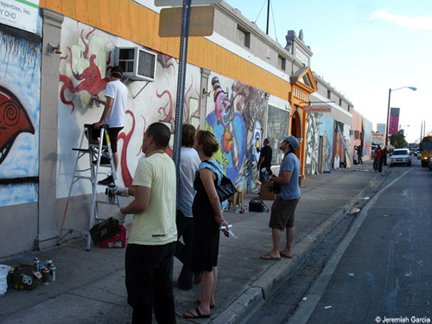Aesthetic Grounds: December 2007 Archives
Patrick Renner in the Christmas Tree exhibition in Buffalo Bayou Artspark, Houston, Texas
In my backyard of southern Florida, not much great Christmas art emerges. Most public Christmas trees, Santa sleighs and Bethlehem manger scenes are of the lowest quality. The people that create the Christmas displays for governments and religious institutions are only interested in visual prominence, not the inventive quality. (See the aestheticgrounds essay on Hindu celebration)
In Florida and elsewhere in the USA, the finest visual displays on public or quasi-public property twinkle in drive-through light-bulb displays. Private groups decorate miles of park landscape with lights and charge a fee per carload. The whiter, the classier.
The best visuals elements of Christmas are neighborhoods filled with private lights on suburban homes. Only at Christmas do suburban values permit the utilization of the home as a public artwork. Only at Christmas do placid homeowners struggle with complex compositional decisions. Only at Christmas do homeowners see the communal street as a physical event.
Of course, the temporary nature avoids the normal demands of conventionality and blandness of the houses and landscapes of suburban neighborhood. Public art agencies, museums and arts ngo's are permitted to step-over-the-line of acceptability through temporary events. The suburbanite forgives the apparent insult, contradiction of normal values or danger to the minds of children. But only one or two times.
(I just deleted my rant on visual repression in the suburbs since it is Christmas.)
As the world's largest celebration with snow imagery no matter the environment outside the window, I thought I would bring an amazing program of the US government. Once a year, artists can apply for an unfunded residency in Antarctica through the National Science Foundation.
Antarctic Artists & Writers Program
The Antarctic Artists & Writers Program provides opportunities for scholars in the humanities (painting, photography, writing, history, and other liberal arts) to work in Antarctica and the Southern Ocean. These visitors will be able to make observations at U.S. Antarctic Program stations and research camps and in wilderness areas. The purpose is to enable serious writings and the arts that increase understanding of the Antarctic and help document America's Antarctic heritage.
The skills of the visual artists range contemporary intellectuals to mediocre landscape painters and photographers. Below are a few interesting ones. (See 2007 Exhibition at the End of the World for other icy works.)
Werner Herzog making his recent film
"ENCOUNTERS AT THE END OF THE WORLD, a documentary film based on the Herzog's perception that the continent's volcanic activity, geological history, evolution and survival of life, represents the inner landscape of our planet. The project will culminate in a feature length film with support from Creative Differences Productions, and the Discovery Channel and will also be distributed on DVD." Sept 10, 2007 was the Official Premiere in Tronto. Not yet available on Netflix.
Yann Arthus-Bertrand. Earth from Above Project.
Kim Baranowki writes in her journal
"Sculptor and gallery installation artist, Kimberly Baranowski's travled to Palmer Station, Antarctica to gather research for her project, The Frozen Field. Her work will be comprised of a series of Antarctic-inspired, large sculptural installations that seek to instill a sense of wonder at the beauty of the region, while bringing to light the potential for instability in the Antarctic Peninsula ecosystem"
Andrea Polli's research results in 1000+ Flickr photos
"Andrea Polli, a digital media artist living and working in New York, specializes in the interpretation and presentation of weather and climate data using sound. Her work is part of a growing interdisciplinary movement in what is called data sonification. Like its counterpart, data visualization, sonification transforms data to communicate meaning."
Cortada buries a Mangrove seeding for a 150,000 year journey to the coast
"Miami artist Xavier Cortada planted a replica of a mangrove seedling in the South Pole.* The mangrove "seedling" was be planted on the 3 km thick glacial ice sheet that blankets the South Pole.
Embedded in the moving glacier, the "seedling" is now begin sliding downhill (9.9 meters every year) in the direction of the Weddell Sea, 1,400 km away. The "seedling" has thus begun its 150,000 year journey towards the seashore, where it can eventually (theoretically) set its roots."
Cortada installation around the official South Pole ceremonial marker.
I could not discover the designer of the ceremonial pole, but it appears designed by Santa's elves. According to the National Science Foundation, on January 1 of every year, a new brass marker is placed at 90 degrees South to designate the location of the Geographic South Pole. The ice sheet where the South Pole is located moves approximately seven meters a year. Previous years' markers are left standing for a few years, illustrating the movement of the ice sheet. Participants wintering at the South Pole design and create the unique markers each year.
1999-2005 designs by the scientists
The South Pole Webcam
Digg it...Del.icio.us ...Technorati...Stumble Upon..Reddit
Charities have been utilizing the thinking and skills of artists for many, many years. From donated works for art auctions - to - donated design and labor for special events. Artists share the values of the charity and the charity typically needs the energy and positive spirit of artists. The Make It Right for New Orleans is one such project of mutual assistance.
The difference with Brad Pitt's latest effort - the Pink Project for Make it Right - is the creative synthesis typical of the film industry. Perhaps public art and urban design could take a lesson. If you listen to Brad Pitt's CNN interview, he describes the process like the film industry with known creative head (Brad Pitt) and complements to many creative anonymous people that made the event happen. Until the Academy Awards, no one even knows the many individual talents.
Somehow through the late night discussions, ideas emerge that link content with filmic visual vision. Heavy borrowing of images occurs from all kinds of designers, artists, architects and film itself. The visuals of the final project must attract the still and moving images of the media.
The Pink Project starts with the color. Pink and orange are the most contrasting colors with the urban and natural world. Yellow has been culturally utilized to signal danger. Red's history is too complicated. (See Aesthetic Grounds on Pink)
The project is a series of boxes and roofs scattered over the demolished residential landscape. The scattered symbolize the anarchy and destruction after the flood. Each time a $150,000 donation is received, a roof is placed on a box that is squared to the street. At the end, a second media opportunity should emerge of an orderly future neighborhood illustrated in pink. As on December 20, 2007, funds have been donated for 42 houses.
Below are some comparative images of the Pink Project with artists Christo and Thom Sokoloski projects this year, the Art Basel Miami Satellite Exhibition and architect Bernard Tschumi's 1982 Parc de la Villette design and Tim Burton's pastel suburb in the 1990 film Edward Scissorhands. (I wish I had artist Stephen Pearson's early 1980's cover of Arts & Architecture Magazine with orderly blue houses on the California lawn.)
If you have forgotten what happened to the Ninth Ward in New Orleans, check out M Styborski Photos
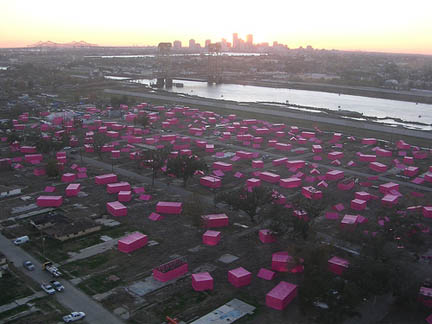
More Aerial Photos at pinknola_07
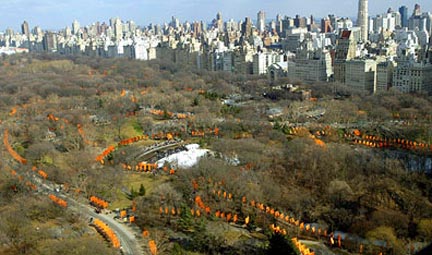
Christo's Orange Gates in Central Park, 2007
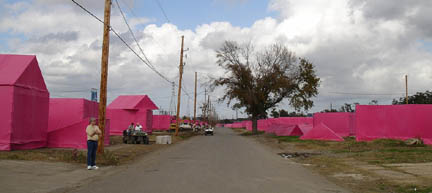
Pink Project past and future street
Tim Burton's 1990 Edward Scissorhands Set
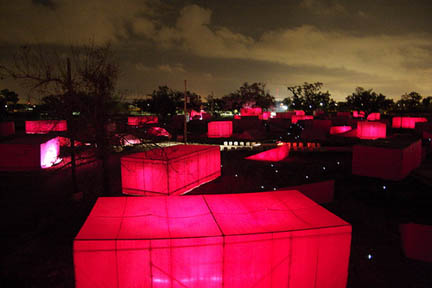
The Pink Project at Night. Photo by Cosmic Ray
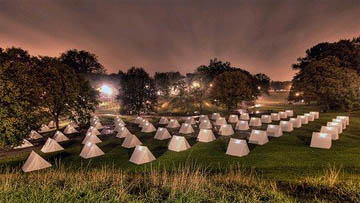
Thom Sokoloski's Encampment Essay, 2007 in NYC
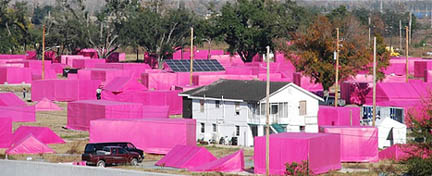
Pink Project on First Day. Photo from NOGodess
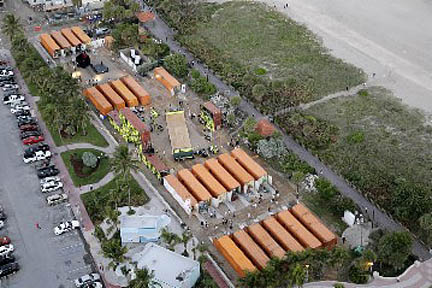
Art Basel Miami Orange Gallery Boxes, 2007
Bernard Tschumi's 1982 Parc de la Villette
Brad Pitt explains the temporary art project to Larry King on CNN
Original 2006 Global Green Sustainable Design for New Orleans is moving forward with the first house to be completed in the next couple of months. Habitat for Humanity has been very successful at going ahead and building.
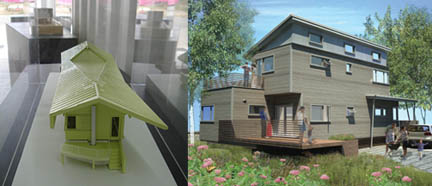
One Make it Right House Design and Global Green Holy Cross Project House Design
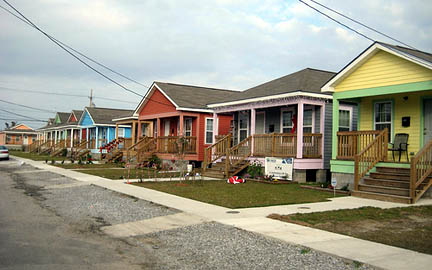
Completed Habitat for Humanity Houses
Digg it...Del.icio.us ...Technorati...Stumble Upon..Reddit
When I fall off the volunteer writing wagon, I need to start up in little bits. So here is one.
Art Basel Miami reminded me of the conservative tendencies in public art. Even the quasi-sponsored public art projects, were without energy. Only the muralist at the primary flight project brought a little freshness to outdoor Miami. My photographs and few downloaded ones are at the AestheticGrounds picasa site.
Question: Does not public art have a responsibility to "record" in the public realm the art of the moment even if the art becomes "dated"? Or even when the administrators do not yet understand the art form?
The newer art in Miami was energized with color, graphics and plastics. So I would like to throw in a few links to some artists that have been working the streets successfully. (On some images, I could read the artist's name. My apology.)
Little People Blog, London
Truthtag, Poland
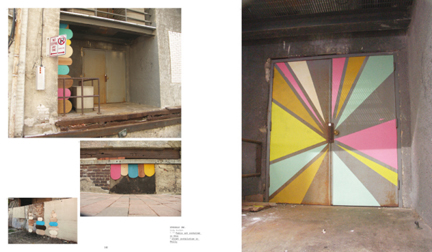
Image from NeoGeo Book
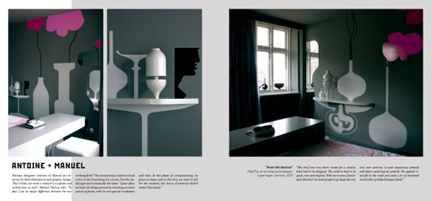
Antoine + Manuel from Hidden Track Book
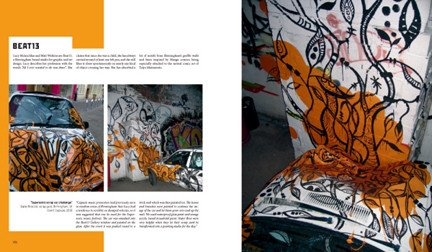
Beat 13 from Hidden Track Book
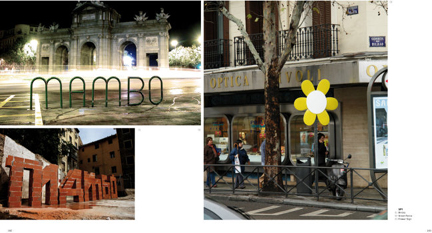
Image from Tactile Book
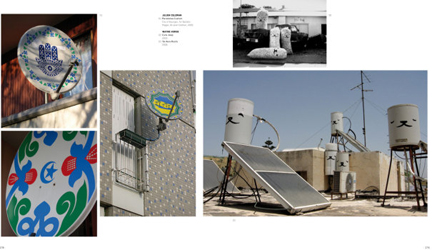
Image from Tactile Book

Image from Tactile Book
Digg it...Del.icio.us ...Technorati...Stumble Upon..Reddit
Blogroll
AJ Ads
AJ Blogs
AJBlogCentral | rssculture
Terry Teachout on the arts in New York City
Andrew Taylor on the business of arts & culture
rock culture approximately
Laura Collins-Hughes on arts, culture and coverage
Richard Kessler on arts education
Douglas McLennan's blog
Dalouge Smith advocates for the Arts
Art from the American Outback
For immediate release: the arts are marketable
No genre is the new genre
David Jays on theatre and dance
Paul Levy measures the Angles
Judith H. Dobrzynski on Culture
John Rockwell on the arts
Jan Herman - arts, media & culture with 'tude
dance
Apollinaire Scherr talks about dance
Tobi Tobias on dance et al...
jazz
Howard Mandel's freelance Urban Improvisation
Focus on New Orleans. Jazz and Other Sounds
Doug Ramsey on Jazz and other matters...
media
Jeff Weinstein's Cultural Mixology
Martha Bayles on Film...
classical music
Fresh ideas on building arts communities
Greg Sandow performs a book-in-progress
Exploring Orchestras w/ Henry Fogel
Harvey Sachs on music, and various digressions
Bruce Brubaker on all things Piano
Kyle Gann on music after the fact
Greg Sandow on the future of Classical Music
Norman Lebrecht on Shifting Sound Worlds
publishing
Jerome Weeks on Books
Scott McLemee on books, ideas & trash-culture ephemera
theatre
Wendy Rosenfield: covering drama, onstage and off
Chloe Veltman on how culture will save the world
visual
Public Art, Public Space
Regina Hackett takes her Art To Go
John Perreault's art diary
Lee Rosenbaum's Cultural Commentary
Tyler Green's modern & contemporary art blog
